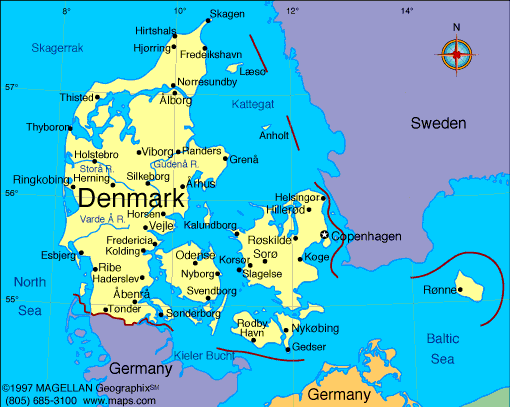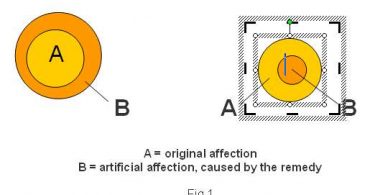In order to understand the situation of homeopathy in Denmark at present it is perhaps necessary to examine what has happened throughout history.
Homeopathy was introduced to Denmark in 1821 by Hans Christian Lund who was a pupil of Hahnemann. After him came Johann Pabst in 1830. By 1835 there was a clash between the conventional and the homeopathic doctors in Denmark (Brade, 1996). Two doctors, Heinrich Hahn (1802-1868) and Holger J. Fangel (1794-1843) published articles and case notes from their practices in favour of homeopathy. The latter published 163 cases treated over a period of 2 years from 1833-1834. The aim was to arouse confidence in doctors, so that they would use the homeopathic system of therapeutics.
The young doctor Karl Kayser (1811-1870), was strongly influenced by the introduction to the exact sciences’ quantitative methods (ibid, 1996).
Kayser criticized the contemporary homeopaths for failing to describe disease in detail and the ensuing treatment. Furthermore, he called for trials in which a neutral substance was given to patients with similar diseases so that it would be possible to monitor if there was an effect from the homeopathic remedy, compared to the neutral substance or whether the patients were cured purely by coincidence.
On top of that, as one therapeutic system of medicine precluded the other, Kayser asked for clear definitions of which diseases and groups of diseases homeopathy could have an effect upon, and a more explicit formulation of the sphere of action of the homeopathic remedies.
The scientific discussions between homeopaths and doctors at the time indicate the preliminary formulation of the randomized controlled trials.
Homeopaths at the time argued that it would be too dangerous to either treat a group of patients with neutral substances (placebo) or not treat them at all, in order to judge the effect of homeopathy. Despite the fact that many irrational methods were still in use (i.e. blood-letting, emetics, starvation, purgatives, setons etcetera), these new rational principles , still based on empiricism, were used to exclude a new system of therapeutics from the world of medicine.
Homeopathic doctors tried to establish homeopathic hospitals in Denmark on three occasions. This occurred in 1874-75, 1911-13 and 1925 respectively. The last homeopathic hospital “survived” for 25 years (Pedersen, 1986). The money to do so had been raised by doctors in favour of homeopathy and by their followers. Consequently, the money from the sale of the last hospital was put into a trust fund whose aim at all times was to establish a homeopathic hospital in Copenhagen (ibid). In 1970 the aim of the foundation was changed by the Ministry of the Interior (the Home Office), so that the money could be allocated to allopathic doctors as well (ibid). This was contested in a lawsuit by an Anthroposophical Fund (The Fund of June 1rst. 1962). They thought it was unwarranted to change the purpose of the Fund to subsidize a treatment that the persons who founded the Fund initially certainly did not support. The case was closed on April 25th 1980, with the Home Office winning the case.
In addition to doctors, increasingly more lay homeopaths practised homeopathy at the beginning of the 1900’s, but that as stopped by a law enacted in 1934, in which it was stated that homeopathic medicine could only be administered by prescription, and only practised by medical doctors (Pedersen, 1986). The Ministry of Health did this, on the pretext that it was dangerous to employ useless homeopathic remedies, which might prevent the patient from getting appropriate medical care. Pedersen (ibid.) questions whether the whole point was to eliminate homeopathy altogether.
In 1973 Otto Ballin and Lis Andersen were fined 3000 kr (app. 500 US dollars) each in the Supreme Court for practising homeopathy. At the same time Otto Ballin took legal action against the Home Office and the Ministry of Health for maintaining the statute that homeopathic medicine could only be administered on prescription. He stated that it was unwarranted, when they considered it to be useless. He gave the example that you could buy table salt at the grocer’s and when diluting it in cooking , it became illegal and you should only be able to use it on prescription. He claimed that the real reason for the statute was the preservation of the allopathic monopoly; to strengthen and preserve that by putting end to homeopathy. Ballin lost the case.
It was not until 1976 that the ministry of health removed the law that restricted homeopathic remedies, with the reference that homeopathic remedies were considered ” harmless and useless.”
In 1978 a naturopathic school was established; Hippokratesskolen. It was modeled on the German education as “heilpraktiker” and homeopathy was one of the main subjects. The first students graduated in 1982.
Apart from the opposition homeopathic doctors and lay homeopaths met from allopathic doctors, there was another challenge just as prominent, which has existed all through history, namely: “We have a report that homoeopathy is not spreading amongst the profession because of lack of organizing spirit.” (Winston, 1999, p. 568) This was cited in a 1911 Directory. Further on: “It lists six doctors (one graduating from Hahnemann in Philadelphia in 1888). There are others who ask not to be known as homeopaths, as there is no certain organization” (Ibid., p. 568).
Today, although apparently 3000 people practise homeopathy (Sall, 2006) only 26 persons are registered with The Danish Association of Classical Homeopathy (DSKH). It is difficult to assess whether 3000 homeopaths is a realistic number, as Sall does not mention from where he gets this number and what it embraces. It is estimated that approximately 50 homeopaths practise classical homeopathy. There are 5.5 million people in Denmark and app. 20000 medical doctors.
DSKH was founded in 1987, by Per Neesgaard and Hans Aage Sørensen along with the School of Classical Homeopathy.
In recent years a lot of work has been done to try to broaden the awareness of homeopathy in Denmark. In 2004 homeopaths from DSKH were included in the group of alternative therapists registered by the Ministry of Health, in order to guide the public in a choice of serious and well educated therapists.
In this context it is necessary to bear in mind that Denmark has a health system in which everyone can always receive free treatment. This is not so for homeopathic treatment, which means that a person requesting homeopathic treatment (or any other alternative treatment) must pay for it himself. This again means that homeopathy is not usually the first or obvious choice when people consider which treatment they need. However, in recent years there has been an increased interest in homeopathy for the treatment of chronic ailments, to come off allopathic drugs and also from families who choose homeopathy as their primary care in acutes et cetera.
Although homeopathy in Denmark still seems to be in it its infancy, due to serious setbacks throughout history, little leaps forward happen all the time.
References:
Brade, A. E. (1996) Set og sket på medicinsk-historisk museum, Copenhagen, Medicinsk-historisk Museums Venner
Pedersen, K. (1986) Homøopatisk håndbog (Handbook of homeopathy), Copenhagen, Borgen
Sall, C. (2006) Homøopatiens tradition i danmark (The homeopathic tradition in Denmark), Dansk homøopatisk selskab, Denmark
Winston, J. (1999) The faces of homoeopathy, Tawa, New Zealand, Great Auk Publishing






hi I am a dr. m.h.mamun. me feel to the danmark
so nice cauntry. and good public cominucation. I hav a diploma for homoeopathy. plies try to me
Hi Kathrine, Thanks for an interesting article – am about to graduate from CHE London and found it most helpful – how interesting to find fellow Danish homeopaths here! Kind regards, Bettina
Hi Bettina, glad you liked the article, and nice to learn about a fellow colleague soon to be 🙂 All the best, Kathrine